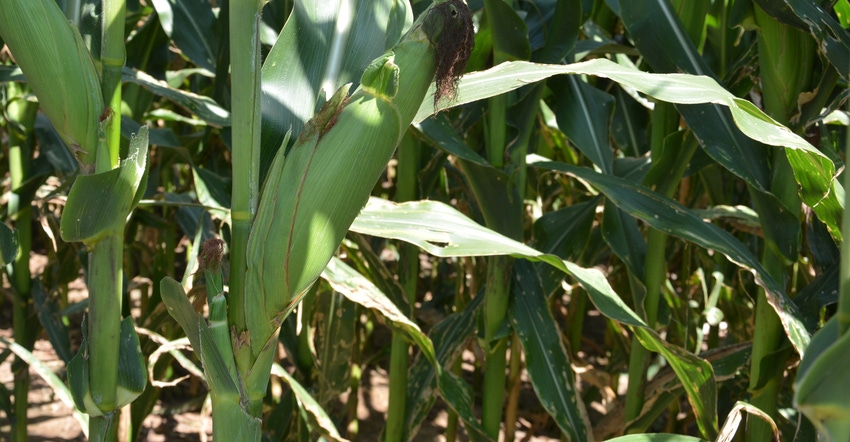
Micronutrients play a big role in the overall health of crops, and a shortage of key micronutrients can have a big impact on yields, says Winfield United agronomist Eric Hanson.
WinField United’s network of retailers are currently in the process of studying tissue samples from Kansas corn and soybean fields and are finding that there are deficiencies of manganese, boron and zinc in the samples they’ve tested for customers, he says.
“We are well past the point where applications of these micronutrients will have an impact on corn,” Hanson says. “But it is a clear indicator that monitoring earlier in the growing season is critical.”
He says manganese is important to the corn plant during the rapid growth period leading up to tasseling because it helps plants with photosynthesis.
“The best way to supplement manganese is foliar,” he says. “We need to monitor tissue earlier in the season and get a supplement on during the stage of plant growth that will offer the best response. We can apply it along with a herbicide of fungicide application.”
Hanson says the important thing is to understand the metabolic process.
“You want to sample tissues to see if the plant is deficient in micronutrient, know what role that micronutrient is responsible for and know that if the plant is going to respond at this point in its growth,” he says.
Although it is also too late in the season for the current corn crop to benefit from an application of boron, if a farmer’s field is deficient it’s likely an early season boron application will be needed for next season’s crop.
“Boron is important in the formation of pollen tubes in corn,” Hanson says. “If the plant reaches tassel and is deficient in boron, you could lose both quality and quantity of pollen that that could be a big issue for pollination. Boron is also responsible for development of the cell wall. With adequate boron, you get better rigidity in the cell wall. Adequate boron also helps improve the mobility of other nutrients.”
He added that the pollen of the corn plant also contains high levels of boron, so a lot of the nutrient is lost during pollination.
Zinc is also at peak importance right around tasseling, he says.
“Zinc is a metal that is important in the metabolic process because it facilitates electron transfer within the plant. That helps the metabolism of the plant as a whole,” he says.
Soybeans need micronutrients, too
For soybeans, manganese is also showing up as a common deficiency in Kansas tissue samples, Hanson says. As it does in corn, manganese helps drive photosynthesis.
Because soybeans are more responsive to micronutrients in the reproductive stages, they can still benefit from a manganese application. He says growers who are spraying soybeans with insecticide or fungicide at early reproductive stages might get some response to adding a supplement such as Max-In Ultra Manganese to the mix.
But growers who learn now that their plant tissues show deficiencies should put tissue testing earlier in the season into their plan for next year, he says.
He says tissue testing is important because soil samples can show the existence of micronutrients in the soil that may not show up in the plant.
“Soil tests will show the existence of the micronutrients, but not whether or not they are readily available to the growing plant,” he says. “The pH level of the soil can be a big factor in nutrient availability. Organic matter also plays a big role. Some nutrients are tied very tightly to organic matter. Others, like boron, aren’t tied tightly to the soil and can be leached down beyond the root zone, much like nitrogen. Manganese becomes more available in saturated soil and we have even seen toxicity in soils that stay wet for long periods of time. As it dries out, manganese becomes more fixed and moves back to a less available form.”
Looking at copper deficiency
Tissues from Kansas fields have also been tested for copper levels. He says soybeans are showing copper deficiency, but in general do not respond to foliar applications of copper. Corn is also non-responsive to foliar copper according to Hanson, but wheat can be highly responsive.
“What we have seen is that wheat does not respond in the fall, but at green-up and flag-leaf in the growing season, it has a tremendous response,” he says. “We don’t know why exactly but that is the kind of thing that makes this line of work and research so exciting.”
Right nutrient at right time
Hanson says the best plan is to rely on layering tissue tests on top of soil tests to get a better understanding of what is there and whether the plant is able to use it.
“What we are looking at is the yield determining growth stages,” he says. “Corn, for example, starts determining ear size at around V6 growth stage. Milo starts determining head size at V7. As plants change and start forming reproductive structures, nutrient needs and the importance of those nutrients changes. Not all crops need the same amount of nutrients and not all growth stages need the same amount of nutrients. We call it ‘elemental prominence,’ knowing what nutrients are important at what growth stages in each crop.”
It is also important to keep records over several years and compare results because growing conditions from year to year can have a major impact on nutrient availability.
He says growers have more access to more information than they have ever had before. However, sorting through all that data and knowing how to use it in making decisions can be more difficult.
“We strive to train our aligned retailers in the agronomy and the science they need to know to help their customers make the best decisions,” Hanson says.
About the Author(s)
You May Also Like






